 OHS professionals need to balance leading with the qualities of both “the head and the heart” in order to become more effective leaders at work, according to author and company director Dr Kirstin Ferguson.
OHS professionals need to balance leading with the qualities of both “the head and the heart” in order to become more effective leaders at work, according to author and company director Dr Kirstin Ferguson.
The art of being a modern leader is knowing what attributes of leading with the head and heart are needed (and when).
“In any given situation, context or conversation you will need to draw on skills from both the head and heart to be the most effective leader you can be. For example, it is impossible to make a critical decision based on well-researched data without also considering the human cost of the decision,” said Dr Ferguson.
“The more attributes of a head and heart leader you can draw upon, the more effective you will be in the widest range of situations you might find yourself leading in.”
Through quantitative and qualitative research, Ferguson explained she has identified the attributes of leading with the head (curiosity, wisdom, perspective and capability) and heart (humility, self-awareness, courage and empathy).
Knowing what attributes of head and heart leadership are needed when is key, according to Ferguson, who said this will take “all your skills of intuition to learn and develop over time”.
“Our experience and maturity as leaders will mean our confidence and ability to integrate our leadership to lead with the head and the heart will change as we expand our experiences,” she said.
Ferguson, who authored Head & Heart: The Art of Modern Leadership and serves as a director on multiple boards, added that many OHS professionals are incredibly effective at leading with their heads.
“They are curious, capable, use risk to make wise decisions and try to ‘read the room’ to lead with perspective and influence outcomes,” she said.
“Just as important though for an OHS professional is to remember to balance those skills with leading with the heart – using humility to accept you may not have all the answers, being self-aware of the impact you have on others, being empathetic around the impact policies and processes you may have on some and being courageous to speak up even in the face of pressure not to do so.”
The other consideration for OHS professionals is to remember that they are a leader regardless of where they may sit in the organisational chart or whether they have a formal ‘seat at the table’.
“People are looking to you to lead at work, at home, in your industry, and in your community. It doesn’t matter whether you have anyone to formally lead in your OHS team or whether you are the sole OHS professional in your organisation,” said Ferguson.
She also observed that the notion of “needing to have followers is a pre-requisite to being a leader” has heavily influenced the notion of leadership as being those who command armies, run large corporations or lead countries.
“If we continue to accept leaders are only those with formal titles and responsibilities who manage or control others, then we exclude, rather than include, most people who are leading in their lives and workplaces,” she said.
“Such a narrow definition of leaders ignores the informal leaders in our organisations, like OHS professionals, who may not have formal authority but who are looked to by those they work with to guide the way.”
Dr Kirstin Ferguson will be presenting a keynote speech at the upcoming AIHS National Health and Safety Conference, which will be held from 30 May to 1 June 2023 at the Brisbane Convention Centre.
This year’s conference theme is “Influence for Impact” and the conference will feature a range of speakers who will examine different aspects of the theme.
If you would like to test your own level of head and heart-based leadership, go to the Head Heart Leader website to receive a free personalised report.
Source: AIHS, 20 January 2023

 Safety Australia Group
Safety Australia Group